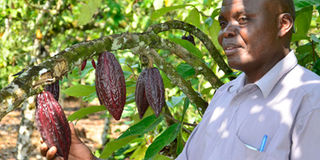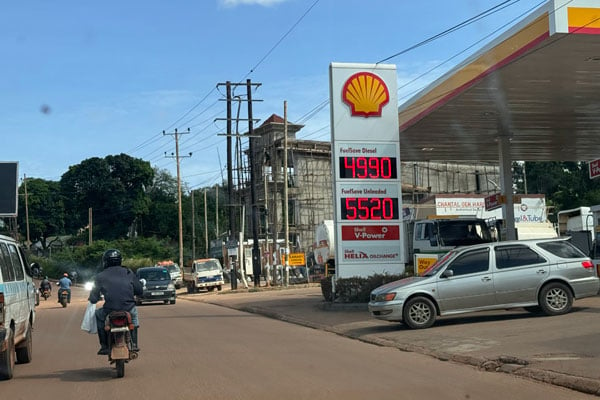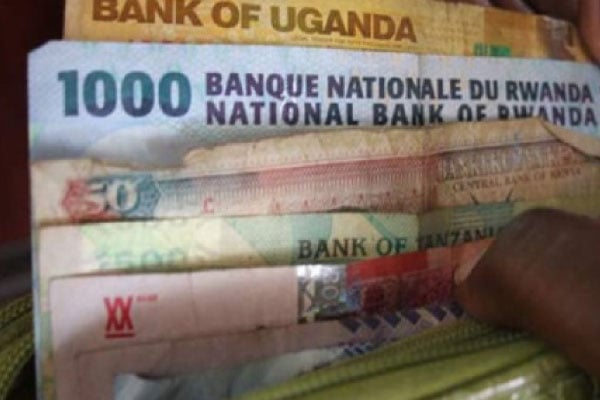Local cocoa prices drop as West Africa Ebola fears subside

A cocoa farmer on his farm in Mukono. Uganda has about 21,000 hectares of land under cocoa cultivation, mostly in the west and central regions. File Photo
What you need to know:
Situation. As the condition returns to normal in West Africa, more tonnes are being posted on the world market offering more options to the buyers
Kampala. While the world is appreciating the containment of the Ebola epidemic in West Africa, Ugandan cocoa producers have to deal with the drop in cocoa prices due to the increased supply of cocoa on the international market from West African producers.
Information from Bundibugyo Cocoa Association (BCA), one of the major producers in Uganda and East Africa indicates a drastic drop in the price of cocoa per kilogramme from Shs7,500 around September to Shs6,500 in November despite the relatively low production.
“If there is an outbreak in West Africa, especially Ivory Coast, you could easily see prices double. With the containment of the Ebola outbreak in West Africa, supply on the international market has increased causing depreciation in the prices. We expect it to hit the Shs7,000 price mark in January, though,” said Mr Methodius Balyesiima, BCA project coordinator.
Until November, Ebola largely affected Sierra Leone, Liberia and Guinea, which produce relatively little cocoa but the last two countries share borders with Ivory Coast, which accounts for almost 40 per cent of the world’s supply of the chocolate ingredient.
Mr Joseph Obela of ICAM Chocolate Uganda ltd, said while Uganda did not have a good season this year, “The forces of demand and supply worked in our (Uganda) favour, we managed to get the best of the international market price due to the Ebola outbreak in major producing countries in Africa.”
Experts argue for its natural aroma, Uganda’s cocoa beans produce a unique chocolate trading high in countries such as Germany, Switzerland and Italy. This has attracted more buyers from Europe, Asia and the Middle East.
“Ebola paralysed trade in West Africa, buyers had to look elsewhere and Uganda was a favourable destination. This pushed competition in terms of prices. But as the condition returns to normal in West Africa, more tonnes are being posted on the world market offering more options to the buyers. The whole world is in a season and the market is circulated with several suppliers.” Mr Obela added
According to David Kyeyune, the cocoa project manager at the Swiss Foundation for Technical Cooperation (SwissContact) Uganda, this year about 1,400 metric tonnes of cocoa worth Shs9.1 billion have been traded though more was expected had it not been for pests and diseases which ravaged the major producing areas of Bundibugyo, Buikwe and Mukono.
Mr Kyeyune added, “There was a lot of speculation at the beginning of the season that West Africa was not going to post much on the world market. Buyers scrambled for cocoa elsewhere but things changed. We expect the prices to rise in January as it will be off season, it is only wise for the farmers to hoard for a few weeks.”
Uganda has about 21,000 hectares of land under cocoa cultivation, mostly in the west and central regions. The crop supports an estimated 10,000 households across the country.
Cocoa cultivation was introduced in Uganda nearly 100 years ago, but its fortunes have varied through the years as government focused on promoting coffee, sugar and tea production.
Mr Kyeyune said, “Production peaked in the 1960s but subsequent government neglect, a lack of finance and price fluctuations poorly affected the sector in the 1970s and 1980s. But there are many factors leading to a price drop, including Ebola.”
About Cocoa
Growth. Uganda’s cocoa trees have increased from one million in 2005 to 5.7 million tress in 2013, according to Cocoa Development Programme data.
Forecast. Cocoa Development Programme Uganda forecasted its cocoa production to rise to 26.3 per cent in the 2013/2014 (Oct-Sep) season from 16 per cent the previous 2013/13 as boosted by yields from new maturing trees.




